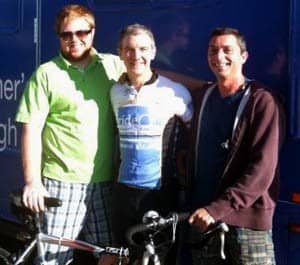UAMS’ Barger Takes Alzheimer’s Passion on the Road
Aug. 16, 2010| UAMS’ Steve Barger, Ph.D., is passionate about Alzheimer’s research and biking. So when he got the rare opportunity to combine those passions in one project, he didn’t hesitate. On Aug. 5-8, Barger biked 270 miles to complete a critical leg of the Alzheimer’s Association’s San Francisco-to-Washington, D.C., Alzheimer’s Breakthrough Ride to raise awareness about the importance of Alzheimer’s research. “When I heard about the idea for the ride, it was something that I really felt compelled to just jump on and participate in,” said Barger, whose lab is at the University of Arkansas for Medical Sciences (UAMS) Donald W. Reynolds Institute on Aging. Alzheimer’s disease is the fourth-leading cause of death among adults, yet National Institutes of Health (NIH) funding for Alzheimer’s research has dropped compared to other diseases such as cancer, heart disease, diabetes and HIV/AIDS. “In 2008, Alzheimer’s disease funding dropped 36 percent and has never really recovered, especially when you factor in inflation,” Barger said. He also notes that the incidence of Alzheimer’s disease is expected to rise from 5.3 million cases to 16 million in the next 40 years, according to the Alzheimer’s Association. In response, the Alzheimer’s Association established the cross-country ride to raise awareness about the importance of Alzheimer’s research and to gather petition signatures urging Congress to make Alzheimer’s research a priority for funding. The Alzheimer’s Breakthrough Ride started on July 17 in San Francisco with four Alzheimer’s disease researchers cycling the first segment of the 4,600-mile route. Barger is one of more than 55 researchers participating in the ride. His leg of the ride is a 270-mile route from Albuquerque, N.M., to Amarillo, Texas. Conceived by Bruce Lamb and organized by the Alzheimer’s Association, the event has attracted more than 55 researchers. Their rides include stops along the way to collect signatures in support of the Alzheimer’s Breakthrough Act and other legislation intended to make Alzheimer’s disease a national priority. The tour will culminate in Washington, D.C., on September 21, World Alzheimer’s Day, when all riders will gather to deliver the petition signatures to Congress. To sign the petition or learn more about the Alzheimer’s Breakthrough Ride and read the riders’ blog, go to http://www.alz.org/research/breakthroughride. “I remember the day I found out the protein that I was working on for my graduate dissertation was connected to Alzheimer’s,” Barger said. “That was exciting and it was a day when I feel like my professional interest and personal motivation came together.” “Nearly everyone either has a family member or knows someone with Alzheimer’s,” he said. “It robs people of their personality, and their loved ones experience an emotional toll that’s often worse than the economic toll.” Barger’s research concerns the pathogenesis of Alzheimer’s, or the mechanism by which the disease is caused. Alzheimer’s disease was discovered more than a century ago, and although physicians and families are caring for more than 5 million Alzheimer’s patients, the chain of events by which the disease develops is still a mystery. Two general hypotheses are being explored in Barger’s laboratory. One involves the suspected role of inflammation in the development and progression of Alzheimer’s disease. In the brain, events related to inflammation are propagated primarily by a specialized type of cell that derives from white blood cells. Barger discovered that when these cells are reacting to minor damage or abnormal substances – particularly those known to appear in Alzheimer’s disease – they release neurotransmitters that can damage or kill nerve cells through hyperstimulation (a process termed “excitotoxicity”). Current work explores ways to manipulate or suppress this release of excess neurotransmitters. A two-year grant received in June for $339,000 will allow Barger to explore a new hypothesis that links several proteins and genes implicated in Alzheimer’s disease. “We think we found a reason why they are all connected, and we’re excited about working on that and hoping it could lead to treatment – hopefully very soon,” he said. Barger also collaborates with UAMS’ Sue Griffin, Ph.D., professor and vice chair of research in the Reynolds Department of Geriatrics. He is project leader and molecular analysis core director for Griffin’s program project grant. Barger’s funds from that source total $2.5 million over five years. Barger also has more informal collaborations with UAMS’ Yuzhi Chen, Ph.D., an Alzheimer’s researcher, and UAMS’ John Crow, Ph.D., whose work is focused on ALS. Barger and Crow have teamed up to work on a neurotransmitter system that appears to be involved in both ALS and Alzheimer’s. ALS is often referred to as Lou Gehrig’s Disease, a progressive neurodegenerative disease that affects nerve cells in the brain and the spinal cord. |


